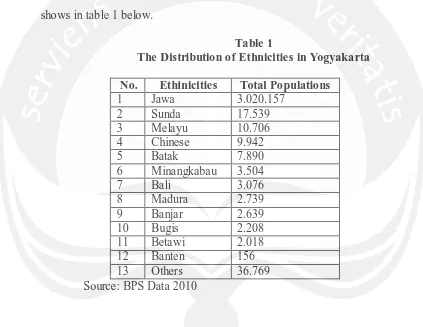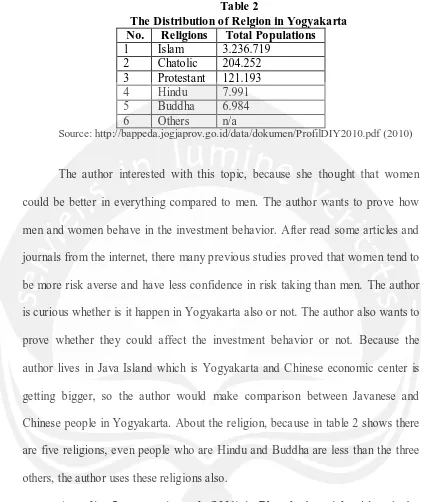CHAPTER I
INTRODUCTION
1.1 Background
People in the world cannot avoid risk. Risk already existed from the
human history. The prehistoric human had brutal lives, as they searched food and
shelter exposed them to physical danger from the beast and poor weather. In this
era, it was already accured the patriarchal culture. A patriarchy comes from the
ancient Greek patriarches, was a society where power was held by and passed
down through the elder males (womenhistory.about.com). According to modern
historians and sociologists a "patriarchal society," means thatthe men hold the
positions of power: head of the family unit, leaders of social groups, boss in the
workplace and heads of government (womenhistory.about.com). It means that
women‟s God‟s will are caring the household and reproductive responsibilities,
such as clean the house; cook, and bear the children. It shows men tend to be more
risk taking compared to women, because they have to be outside their house and
meet the family‟s needs.
Indonesia also adopt the patriarchal culture
(http://www.kabarindonesia.com).Women are subordinate to men within the
family and the state or government and their primary civic duties are performed in
their role as wives and mothers (www.antaranews.com). In the Indonesia‟s
political and economic structures also were almost exclusively to men. According
be assertive, tought, and focused on material success; women are supposed to be
more modest, tender, and concerned with the quality of life.
Talk about the ethinicity in Indonesia, there are many ethinicities
there. Badan Pusat Statistik (BPS) in 2010 held an survey about how many
ethicities in Indonesia (www.jpnn.com). The result of this survey was 1128
ethinicities including the Chinese people in Indonesia. Because this research
will be held in Yogyakarta, the distribution of the ethinicities in Yogyakarta
[image:2.596.87.510.270.597.2]shows in table 1 below.
Table 1
The Distribution of Ethnicities in Yogyakarta
No. Ethinicities Total Populations
1 Jawa 3.020.157
2 Sunda 17.539
3 Melayu 10.706 4 Chinese 9.942
5 Batak 7.890
6 Minangkabau 3.504
7 Bali 3.076
8 Madura 2.739 9 Banjar 2.639 10 Bugis 2.208 11 Betawi 2.018 12 Banten 156 13 Others 36.769 Source: BPS Data 2010
There are five religions in Indonesia. They are Islam, Protestant, Chatolic,
Buddha, and Hindu. The distribution of the religion in Yogyakarta shows in this
Table 2
The Distribution of Relgion in Yogyakarta No. Religions Total Populations 1 Islam 3.236.719
2 Chatolic 204.252 3 Protestant 121.193 4 Hindu 7.991 5 Buddha 6.984 6 Others n/a
Source: http://bappeda.jogjaprov.go.id/data/dokumen/ProfilDIY2010.pdf (2010)
The author interested with this topic, because she thought that women
could be better in everything compared to men. The author wants to prove how
men and women behave in the investment behavior. After read some articles and
journals from the internet, there many previous studies proved that women tend to
be more risk averse and have less confidence in risk taking than men. The author
is curious whether is it happen in Yogyakarta also or not. The author also wants to
prove whether they could affect the investment behavior or not. Because the
author lives in Java Island which is Yogyakarta and Chinese economic center is
getting bigger, so the author would make comparison between Javanese and
Chinese people in Yogyakarta. About the religion, beca use in table 2 shows there
are five religions, even people who are Hindu and Buddha are less than the three
others, the author uses these religions also.
According Loewenstein et al. (2001) in Bhugaloo‟s article, risk attitudes
differ betweenmen and women because of the role of emotional variables. The
emotional reactions drive attitudes and behavior in a stronger way than cognitive
judgments. Emotions which matter in the context of decision making are mainly
background mood of the decision maker, on the time course of the decision
etc.Because of better imagery, women appear more risk averse than men.
Extensive empirical evidence suggests that women are more risk averse
than men. One study conducted by Weber et al. (2002) involved a survey to
quantify five distinct risk domains: financial risks, health and safety risks,
recreational, ethical and social risks
(http://arethuse.webs.ull.es/mesasdetrabajo/ponenciafrancodangelo.pdf).
Their results indicated that women were more risk-averse in all domains except
social risk. Hinz et al. (1997), Sunden and Surette (1998), and Olsen and Cox
(2001) found that increased risk aversion affects the investment choices of women
(http://www.efmaefm.org/efma2006/papers/538612_full.pdf).
All of those issues relate with behavioral finance which is a field of
finance that proposes psychology-based theories to explain stock market
anomalies (www.investopedia.com). Within behavioral finance, it is assumed that
the information structure and the characteristics of market participants
systematically influence individuals' investment decisions as well as market
outcomes (www.investopedia.com).
Generally, investors are selective and have certain preferences in investing
their funds. Investors‟ behavior and preferences are influenced by many factors
both internal and external. The dominant factor that influences the investors‟
investment activity is both demographic and psychographic factors. Demographic
characteristics include gender, age, education level, income, marital status and
employment, while the psychographic characteristics of an investor are observed
(www.businessdictionary.com). Lewellen et al.(1977) in their reserach,
determined that age, sex, income and education affect investor preferences for
capital gains, dividend yield and overall return.
“Finance theory conventionally focuses on risk and return as the factors
relevant to the construction of portfolios. But there is evidence of a growing number of investors who wish to incorporate moral or social concerns in their
decision -making.”
(Anand & Cowton, 1993)
As cited from Dr. Nurasyikin Jamaludin‟s research (2013), religion has
been inferred as a potential determinant of savings and inves tment behaviour
(Keister, 2003). The values, habits and attitudes of an individual could affect it.
Jamaludin also stated that many studies have examined religion could affect
people‟s values, habits, attitudes, and behaviour.
Muhamad, S.Susela Devi, and Abdul Mu‟min (2006) researched about the
affect of religion on individual investment decision making. This research focused
on Islamic religiosity on the investment decision making among the Malaysian
Malay Muslim investors. From the research, they found that the degree of
religiosity has a significant influence on investment decision making.
The research about racial differences in individual investment decisions
has received less attention compared to racial differences in economic decision
making (Gutter et al., 1999). The other research conducted by Zhong and Xiao
(1995), to analyze the factors associated with families holding stocks or bonds,
they used the 1989 Survey of Consumer Finances. They found that race also a
factor in determining stock ownership. The other factors that become factors in
In this research, the author would to analyse whether gender, ethinicty, and
religion effect the investment behavior, which is different types of confidence.
The comparison between men and women; Chinese and non Chinese (Javanese);
and Islam, Chatolic, Protestant, Hindu, and Buddha while taking a risk also stated
in this research.
1.2 Proble m State ments
This research concerns in gender differences toward risk preferences in
investing their funds. In some research women are tend to be risk averse than
men. They are more conservative in making investment decision. The other
factors that influence their behaviour are age, ethnicity, and religion. Based on the
research background above, so the problems of the study are as follows:
a. Do gender, ethnicity, and religion influence the investors‟ risk taking
level?
b. Do gender, ethnicity, and religion influence the individual investment
behavior, which is different type of confidence?
c. Are men more risk taking than women?
d. Are men more confidence than women?
1.3 Research Scope
The scopes of the research are as follows:
a. This research replicated a previous study by Mohamed Albaity and
Ethnicity, and Religion and Investment Decision: Malaysia Evidence” in
two public universities in Malaysia.
b. The sample of the research is students in the Pojok Bursa Atma Jaya
Yogyakarta (UAJY), Universitas Pembangunan Nasional (UPN), STIE
YKPN, Universitas Kristen Duta Wacana (UKDW), Universitas Gajah
Mada (UGM), Universitas Islam Indonesia (UII), Universitas Negeri
Yogyakarta (UNY), Universitas Teknologi Yogyakarta (UTY).
c. The author categorizes the other factors that can influence the investor
behavior between men and women. They are ethnicity and religion of the
investor.
1.4 Research Objectives
a. To examine whether gender, ethnicity, and religion influence
investors‟ risk taking level.
b. To examine whether gender, ethnicity, and religion influence the
individual investment behavior, which is different type of confidence.
c. To examine whether men are more risk taking than women.
1.5 Research Benefits
Benefits of the study are:
a. For the financial advisors
This research is expected to make better understanding of how investors
behave towards the market movement and the financial advisors could give
the best suggestions to their clients to allocate their assets well.
b. For the investors
This research is expected to help the investors to make a right decision before
they sell or buy the stocks.
c. For Academic
This research is expected to be a reference for the readers to have better
understanding of investor behavior between men and women in Yogyakarta
and what factors are influencing it; before they want to enter the stock
market.
1.6 Research Report Outline
The writting of this proposal is devided into three chapters, they are:
a. Chapter I Introduction
This chapter presents the introduction about the research. It consists of
research background, problem statement, scope of the research, benefits of
b. Chapter II Theoretical Background and Previous Research
This chapter contains introduction, the related previous research, theoretical
background, and hypothesis development.
c. Chapter III Research Methodology
This chapter provides information about population, sample, and sampling
method; research method; data collection method; and analysis method.
d. Chapter IV Data Analysis
This chapter addresses the data analysis and explanation of the result obtained
in this research.
e. Chapter V Conclusion and Recommendation
The last chapter consists of the conclusion of this reasearch as well as the

